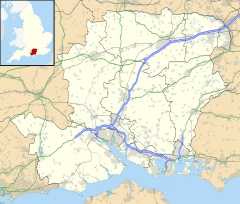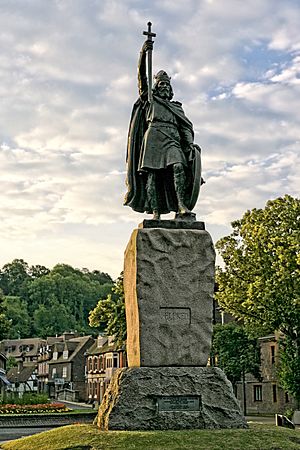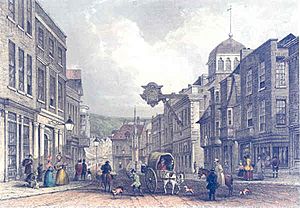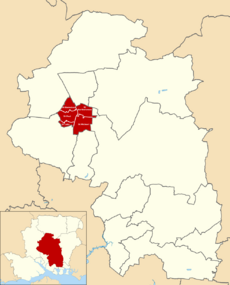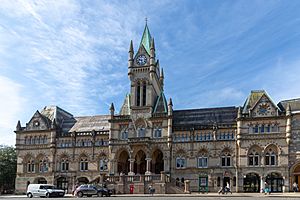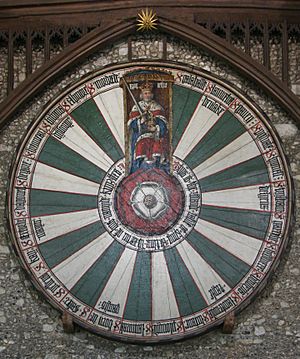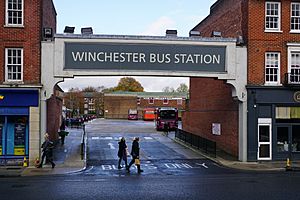Winchester facts for kids
Quick facts for kids Winchester |
|
|---|---|
| City | |
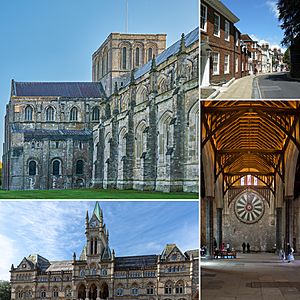 Clockwise from top left: Winchester Cathedral, Great Minster Street, Great Hall of Winchester Castle and Winchester Guildhall |
|
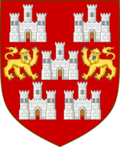 Coat of arms of Winchester |
|
| Population | 48,478 |
| OS grid reference | SU485295 |
| • London | 60 miles (97 km) |
| District |
|
| Shire county | |
| Region | |
| Country | England |
| Sovereign state | United Kingdom |
| Post town | WINCHESTER |
| Postcode district | SO22, SO23 |
| Dialling code | 01962 |
| Police | Hampshire |
| Fire | Hampshire |
| Ambulance | South Central |
| EU Parliament | South East England |
| UK Parliament |
|
Winchester is a historic city in Hampshire, England. It's known as a cathedral city because it has a very old and important cathedral. The city sits by the River Itchen at the western edge of the South Downs National Park.
Winchester is about 60 miles (97 km) southwest of London. It's also just 14 miles (23 km) from Southampton, which is its closest big city. In 2021, about 48,478 people lived in Winchester. The larger area of Winchester, which includes towns like Alresford, had about 127,439 people. Winchester is the main town of Hampshire and home to the county council offices.
The city grew from a Roman town called Venta Belgarum. Before that, it was an Iron Age settlement. Winchester was one of the most important cities in England until the Norman conquest in the 11th century. Today, it is known as one of the more expensive and well-off areas in the United Kingdom.
Winchester's most famous building is Winchester Cathedral. The city also has the University of Winchester and Winchester College. Winchester College is the oldest public school in the UK that still uses its original buildings.
Contents
A Look at Winchester's Past
Early Settlements
The area around Winchester has been lived in for a very long time, even before recorded history. There are three Iron Age hillforts nearby: Oram's Arbour, St. Catherine's Hill, and Worthy Down. These were fortified settlements on hills. Later, a more town-like settlement called an oppidum developed.
This settlement became an important place for the Belgae tribe. The name "Winchester" comes from an old Celtic word, "Venta," which meant "tribal town" or "meeting place."
Roman Times
After the Roman conquest of Britain, the Romans called the town Venta Belgarum. This meant "Venta of the Belgae." At first, other Roman towns were more important, but Winchester grew to be a major city by the late 2nd century.
In the early 3rd century, Winchester got stone walls to protect it. The city covered about 144 acres, making it one of the largest Roman towns in Britain. However, like many Roman towns, Winchester started to decline in the late 4th century.
Medieval History
After the Romans
Even after the Romans left Britain, people continued to live in Winchester. The town became smaller, but its defenses were improved. It might have been a center for a religious group or a royal palace.
Winchester is mentioned in old Welsh writings as "Cair Guinntguic." In modern Welsh, it's called "Caerwynt."
Kingdom of Wessex
The city became known as Wintanceaster in Old English, meaning "Fort Venta." In 648 AD, King Cenwalh of Wessex built the Church of St Peter and St Paul. This church later became the Old Minster and then a cathedral.
The city's current layout comes from the late 9th century. King Alfred the Great changed the Roman street plan to a new grid. This helped to defend the city better against the Vikings. Winchester also had its first mint for making coins around this time.
In the early 10th century, two new religious buildings were founded: the Nunnaminster (a convent) and the New Minster. Bishop Æthelwold of Winchester was important in reforming monasteries. He also created a drainage system called the "Lockburn," which was used until 1875. The Old Minster became a center for the worship of Saint Swithun, a 9th-century Bishop of Winchester.
Historians believe that Winchester was a very important city for the West Saxon kingdom, especially during Alfred the Great's time.
Medieval Decline and Revival
A fire damaged the city in 1141. In the 14th century, William of Wykeham helped to restore Winchester. As Bishop of Winchester, he was responsible for much of the cathedral's current look. He also founded Winchester College, which is still a famous school today.
During the Middle Ages, Winchester was a major center for the wool trade. After this, the city slowly declined. The curfew bell in the bell tower still rings at 8:00 pm every evening.
Jewish Community
Jewish people lived in Winchester from at least 1148. In the 13th century, the Jewish community here was one of the most important in England. Their area was in the heart of the city, now called Jewry Street. Sadly, all Jews were expelled from England in 1290. A statue of Licoricia of Winchester, a very important Jewish woman from medieval England, was put up in Jewry Street in 2022.
Modern Winchester
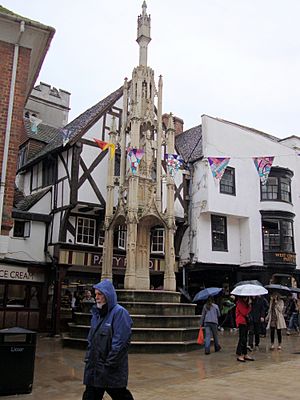
The City Cross, also known as the Buttercross, dates back to the 15th century. It has 12 statues of saints and historical figures. In 1770, people in the city stopped it from being moved, showing how much they cared about it. The Buttercross was restored in 1865 and still stands in the High Street.
The city walls were first built by the Romans. Over time, parts of the walls were rebuilt and expanded. Many sections were taken down in the 18th and 19th centuries because they were falling apart or blocking traffic. Only a small part of the original Roman wall remains. Of the six old gates, only the Kingsgate and Westgate are still standing.
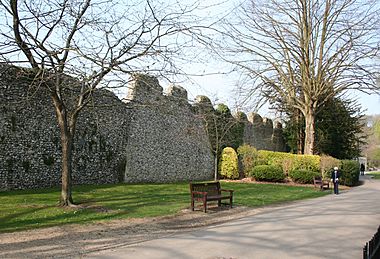
Winchester has several important statues. These include a large statue of Queen Victoria by Sir Alfred Gilbert, a statue of King Alfred by Hamo Thornycroft, and the modern Horse and Rider by Dame Elizabeth Frink.
The famous novelist Jane Austen died in Winchester in 1817 and is buried in the cathedral. The poet John Keats wrote several well-known poems while staying in Winchester in 1819, including "To Autumn".
In recent years, Winchester has been called one of the most expensive and desirable places to live in the UK. This is because of its history, architecture, and good transport links.
Geography and Climate
Winchester is built on chalk, with some areas of clay and loam soil. The city is located in a beautiful natural setting.
Climate
Winchester has an oceanic climate, which means it has mild winters and cool summers. It gets rain throughout the year. The nearest weather station is in Martyr Worthy, just outside the city.
| Climate data for Martyr Worthy, (1991–2020 normals, extremes 1959–2002) | |||||||||||||
|---|---|---|---|---|---|---|---|---|---|---|---|---|---|
| Month | Jan | Feb | Mar | Apr | May | Jun | Jul | Aug | Sep | Oct | Nov | Dec | Year |
| Record high °C (°F) | 14.0 (57.2) |
16.1 (61.0) |
20.0 (68.0) |
23.5 (74.3) |
27.8 (82.0) |
34.0 (93.2) |
33.5 (92.3) |
34.7 (94.5) |
28.3 (82.9) |
26.1 (79.0) |
18.3 (64.9) |
14.8 (58.6) |
34.7 (94.5) |
| Mean daily maximum °C (°F) | 7.8 (46.0) |
8.4 (47.1) |
11.1 (52.0) |
14.2 (57.6) |
17.9 (64.2) |
20.5 (68.9) |
22.9 (73.2) |
22.6 (72.7) |
19.7 (67.5) |
15.2 (59.4) |
10.9 (51.6) |
8.3 (46.9) |
15.0 (58.9) |
| Daily mean °C (°F) | 4.7 (40.5) |
4.9 (40.8) |
6.9 (44.4) |
9.2 (48.6) |
12.4 (54.3) |
15.1 (59.2) |
17.2 (63.0) |
17.2 (63.0) |
14.6 (58.3) |
11.3 (52.3) |
7.5 (45.5) |
5.1 (41.2) |
10.5 (50.9) |
| Mean daily minimum °C (°F) | 1.5 (34.7) |
1.4 (34.5) |
2.7 (36.9) |
4.2 (39.6) |
6.9 (44.4) |
9.6 (49.3) |
11.5 (52.7) |
11.8 (53.2) |
9.5 (49.1) |
7.3 (45.1) |
4.0 (39.2) |
1.9 (35.4) |
6.0 (42.8) |
| Record low °C (°F) | −13.0 (8.6) |
−10.7 (12.7) |
−9.4 (15.1) |
−6.1 (21.0) |
−4.1 (24.6) |
−0.7 (30.7) |
2.8 (37.0) |
−0.1 (31.8) |
−0.1 (31.8) |
−4.7 (23.5) |
−8.6 (16.5) |
−11.8 (10.8) |
−13.0 (8.6) |
| Average precipitation mm (inches) | 81.6 (3.21) |
57.6 (2.27) |
50.9 (2.00) |
50.9 (2.00) |
49.2 (1.94) |
45.2 (1.78) |
52.9 (2.08) |
57.8 (2.28) |
54.6 (2.15) |
86.0 (3.39) |
91.4 (3.60) |
75.6 (2.98) |
753.6 (29.67) |
| Average precipitation days (≥ 1.0 mm) | 12.7 | 10.2 | 9.3 | 9.7 | 8.6 | 8.4 | 9.0 | 9.0 | 8.9 | 11.7 | 12.9 | 12.5 | 123.0 |
| Mean monthly sunshine hours | 57.1 | 80.2 | 115.8 | 168.4 | 199.5 | 190.6 | 201.5 | 186.4 | 146.7 | 108.5 | 69.6 | 55.2 | 1,579.3 |
| Source 1: Met Office | |||||||||||||
| Source 2: Starlings Roost Weather | |||||||||||||
How Winchester is Governed
From 1835 to 1974, Winchester was run as a municipal borough within Hampshire. Since 1974, it has been part of the larger City of Winchester district. This district has 16 voting areas, called wards. Five of these wards cover the city itself.
The city wards form the Winchester Town Forum. This group helps make decisions for the town area. Its members are the city councillors who were elected to those wards.
Winchester is currently represented in the House of Commons by Danny Chambers, a Liberal Democrat.
The Mayor of Winchester is a ceremonial role today, but it dates back to the late 12th century. The mayor serves for one year and leads the Winchester City Council.
Famous Landmarks
Winchester Cathedral
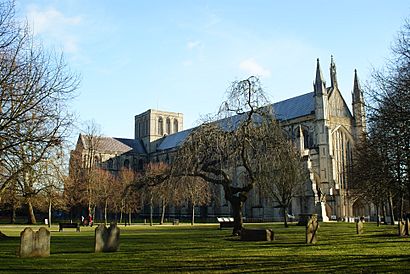
Winchester Cathedral was first built in 1079. It is the longest Gothic cathedral in Europe. Inside, you can see amazing architecture from the 11th to the 16th centuries. Many important people are buried here, including Anglo-Saxon kings like Egbert of Wessex and King Canute.
The cathedral was once a major place for pilgrims. It held the shrine of Saint Swithun. The ancient Pilgrims' Way to Canterbury starts in Winchester. The old Old Minster building's outline is marked in the grass next to the cathedral. The cathedral has both a girls' and a boys' choir who sing regularly.
Around the cathedral, there are many old buildings from when it was a priory (a monastery). The Deanery is from the 13th century and was the birthplace of Arthur, Prince of Wales in 1486. The Pilgrims' Hall is the oldest hammer-beamed building still standing in England. It was built in 1308 and used to house pilgrims visiting Saint Swithun's shrine. Today, it's part of The Pilgrims' School.
Wolvesey Castle and Palace
Wolvesey Castle was the palace of the Norman bishops, built in 1110. It stands on the site of an even older Saxon building. In the 16th century, Queen Mary Tudor and King Philip II of Spain stayed here before their wedding in the cathedral. Today, the building is a ruin, but its chapel is part of a newer palace built in the 1680s.
Winchester Castle
Winchester is famous for the Great Hall of its castle. This hall was rebuilt between 1222 and 1235 and still stands today. It is known for King Arthur's Round Table, which has been there since at least 1463. The table itself is from the 13th century. It was painted for Henry VIII in 1522. The names of the legendary Knights of the Round Table are written around its edge, with King Arthur at the top.
Next to the hall are the modern Law Courts. A recreation of a medieval garden is also in the castle grounds. The nearby King's House is now part of the Peninsula Barracks, which houses five military museums.
Hospital of St Cross
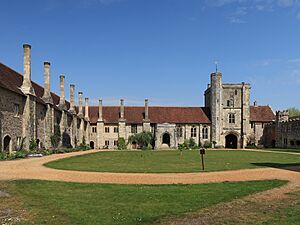
The almshouses and large Norman chapel of the Hospital of St Cross were founded in the 1130s. Since at least the 14th century, and still today, visitors can receive a "wayfarer's dole" of ale and bread. This was meant to help pilgrims traveling to Canterbury.
City Museum
The City Museum is on the corner of Great Minster Street and The Square. It has lots of information about Winchester's history. You can see Roman artifacts from Venta Belgarum and even old shop interiors from the High Street. Other interesting places include the Westgate Museum, which shows old weaponry, and the Historic Resources Centre, with city records.
Other Buildings of Interest
Other historic buildings include the Guildhall, built in 1871 in the Gothic revival style. The Royal Hampshire County Hospital is another notable building. Winchester City Mill is one of the city's old water mills powered by the River Itchen. The mill has been restored and still grinds corn using water power. It is owned by the National Trust.
Castle Hill is where the Council Chamber for Hampshire County Council is located.
Between Jewry Street and St Peter's Street is St Peter's Catholic Church, built in 1924. Next to it is Milner Hall, which was the first Catholic church to be consecrated in England since 1558.
The old Victorian Corn Exchange is now a place for cultural events.
Painted Bollards
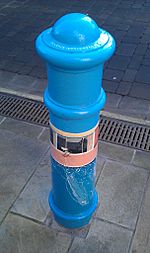
On the corner of Great Minster Street and The Square, you can see a series of 24 bollards. These were painted by The Colour Factory between 2005 and 2012. They are painted in the style of famous artists or with fun, local scenes.
Education in Winchester
Winchester has many schools, both state-funded and independent.
Primary Schools
The city has several Church of England primary schools. St Peters Catholic Primary School has achieved high results in national tests.
Secondary Schools
There are four state secondary schools in Winchester: the Henry Beaufort School, Kings' School Winchester, and The Westgate School. The Osborne School is a special school for students with specific needs.
Independent Schools
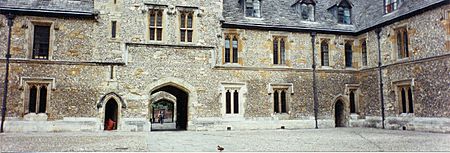
Independent junior schools include The Pilgrims' School Winchester and Prince's Mead School. Twyford School, just outside the city, claims to be the oldest preparatory school in the UK.
Winchester has two major independent senior schools: St Swithun's (for girls) and Winchester College (for boys). Both schools often have excellent exam results.
Special Schools
Osborne School is a state-funded special school for students aged 11 to 19 in Winchester. Shepherds Down Special School is for younger pupils aged 4 to 11, located near the city.
Colleges and Universities
The University of Winchester (formerly King Alfred's College) is a public university. It is known for its teaching quality and student satisfaction. Its history goes back to 1840 as a teacher training center. The main campus is near the city center.
The Winchester School of Art was founded in the 1860s and is now part of the University of Southampton.
Peter Symonds College is a college that serves Winchester. It started as a grammar school for boys in 1897 and became a co-educational college in 1974.
Sports in Winchester
Winchester has several sports teams and clubs.
- Football: Winchester City FC and Winchester Castle FC are local football clubs. There's also Winchester City Flyers, a girls' and women's football club. Winchester Walking Football is a club for walking football.
- Rugby: Winchester RFC is the city's rugby union team.
- Athletics: Winchester and District AC is the local athletics club.
- Hockey: Winchester Hockey Club is the city's field hockey club.
- Bowls: Lawn bowls is played at several clubs, including Friary Bowling Club (since 1820) and Hyde Abbey Bowling Club (established 1812).
- Golf: There are three 18-hole golf courses: Royal Winchester Golf Club, Hockley Golf Club, and South Winchester Golf Club.
- Unique Sport: Winchester College invented its own sport, Winchester College football.
Getting Around Winchester
Roads
Winchester is close to the M3 motorway. It's also where major roads like the A34, A31, A3090, and A272 meet. The city can get busy with traffic during peak times.
A Roman road from Salisbury ends in Winchester. This old road is now a walking path called the Clarendon Way.
Bus Services
Local and longer-distance bus services are provided by companies like Stagecoach South and Bluestar. You can catch buses to nearby towns like Andover, Southampton, and Eastleigh. National Express and Megabus offer long-distance services to other cities in the UK.
Community Transport
Winchester City Council offers special transport schemes:
- Dial-A-Ride: This service helps people with mobility issues get around the city in wheelchair-friendly minibuses.
- Voluntary Car-Share: Volunteer drivers use their own cars to help people who need transport, like those going to medical appointments.
- Wheels to Work: This scheme helps young people (16-25) get to work, training, or interviews by lending them a moped.
Rail Services
Winchester railway station is served by South Western Railway trains. You can travel to London Waterloo, Weymouth, Portsmouth, and Southampton. CrossCountry trains also connect Winchester to cities like Manchester and Newcastle via Birmingham.
There used to be another station, Winchester Chesil, which closed in the 1960s.
Media and Culture
Since 1974, Winchester has hosted the annual Hat Fair. This is a fun celebration of street theatre with performances and workshops all around the city.
Winchester is home to Blue Apple Theatre, a theatre company that helps performers with learning disabilities create plays, dances, and films. Platform 4 is another performance and visual arts company based here.
The city hosts one of the UK's largest farmers' markets, with about 100 stalls. It takes place on the second and last Sunday of each month. Winchester also has a popular Winchester Cathedral Christmas Market from mid-November until Christmas.
Four newspapers cover Winchester: the Hampshire Chronicle, the Southern Daily Echo, the Mid-Hants Observer, and the Hampshire Independent. Winchester also had its own radio station, Win FM, from 1999 to 2007.
In 2006, a TV show called Winchester the "Best Place in the UK to Live in." In 2016, it was again named the best place to live in Britain by the "Sunday Times Best Places To Live" guide.
International Connections
Winchester is twinned with:
- Laon, France
The wider Winchester district is twinned with:
- Giessen, Germany
Winchester, Virginia, in the USA, is named after the English city. The Mayor of Winchester, England, is always invited to the American city's Shenandoah Apple Blossom Festival. Winchester also gave its name to a suburb of Paris, France, called Bicêtre. This name came from a manor built there by a Bishop of Winchester in the late 13th century.
See also
 In Spanish: Winchester para niños
In Spanish: Winchester para niños


